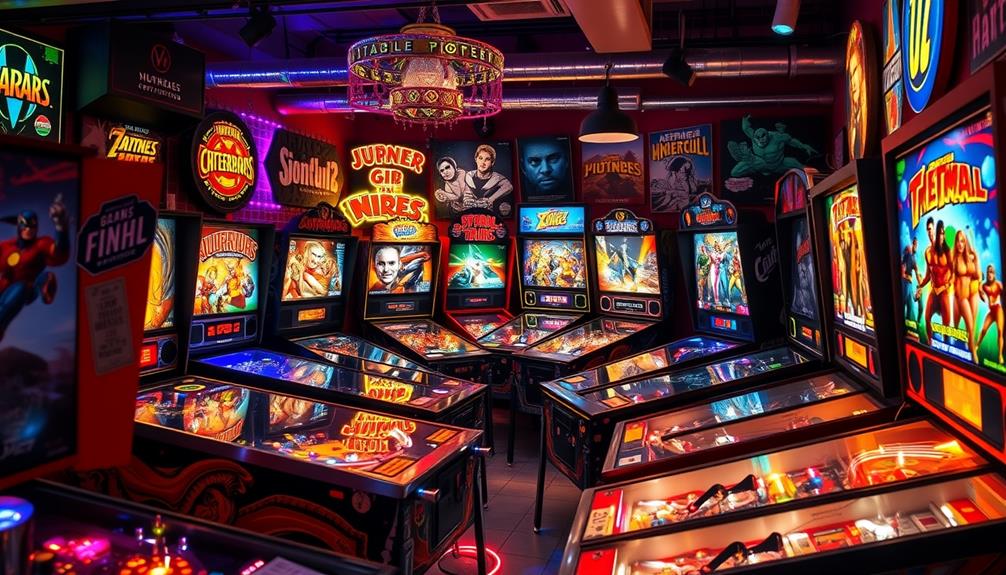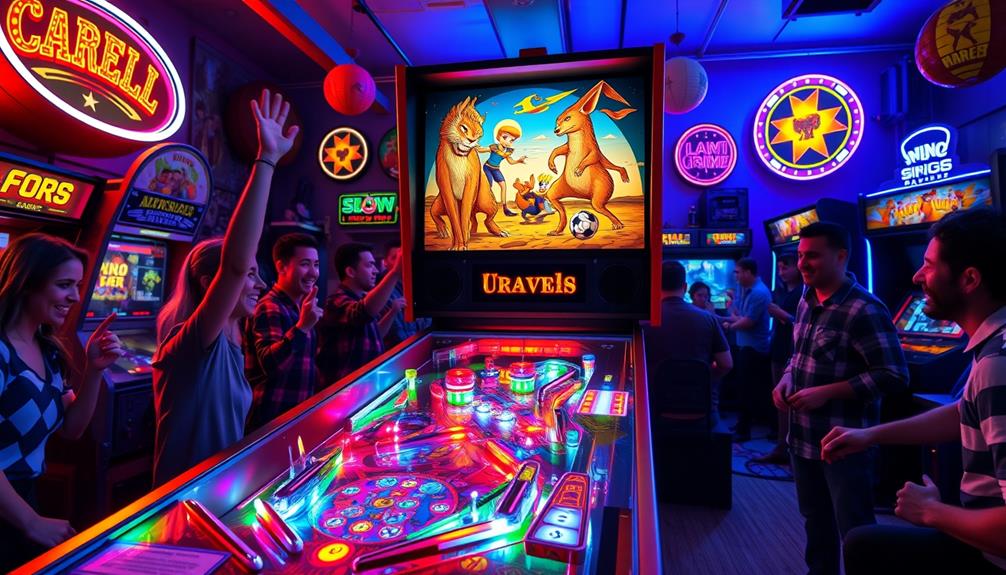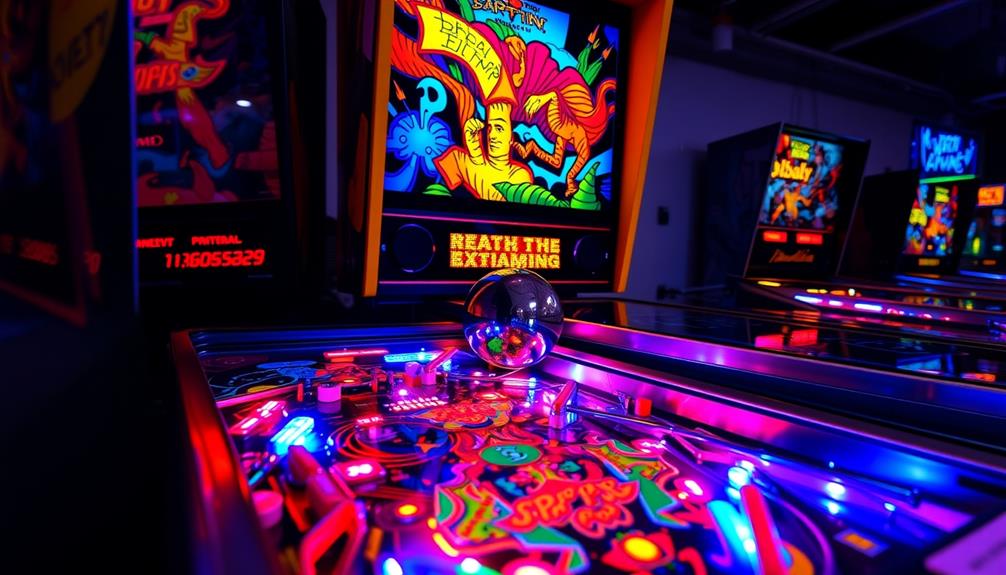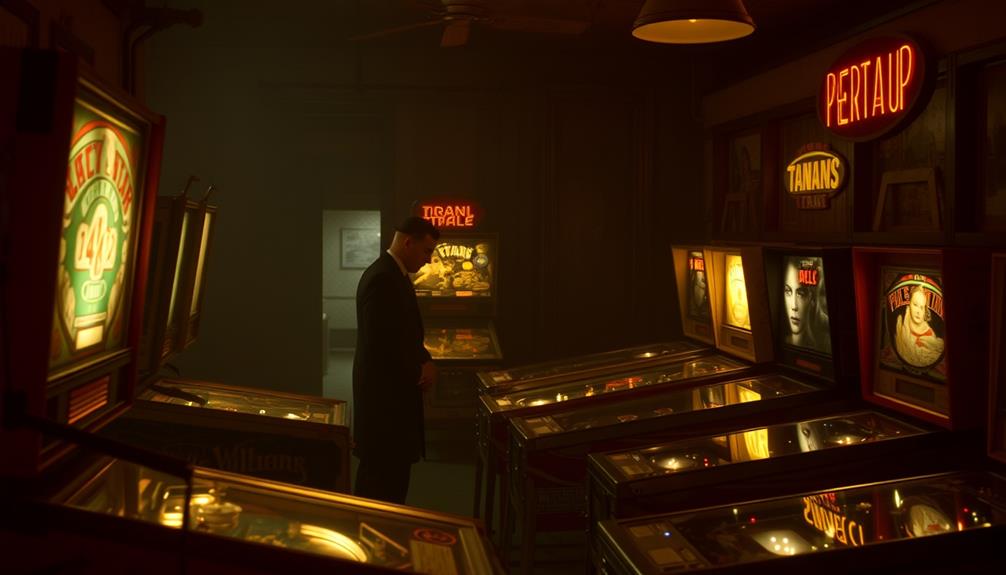There have been approximately 5,000 unique pinball machine designs created since the 1930s. Each decade brought new innovations and themes, creating a diverse landscape for pinball. From the early wooden games to the introduction of electric flippers in 1947, each era has contributed to the rich history of pinball. Major manufacturers such as Gottlieb and Williams have played significant roles in shaping these machines. The pinball community continues to thrive, embracing both classic and modern models. If you’re interested in learning more about the evolution and cultural impact of pinball, there is a wealth of fascinating information waiting for you.
Key Takeaways
- Over 3,000 distinct pinball machine designs have been produced since the 1930s, with approximately 5,000 unique designs documented throughout history.
- The production of pinball machines saw significant declines in the 2000s, dropping to fewer than 100 machines annually.
- Major manufacturers like Gottlieb, Williams, and Bally significantly shaped the industry, contributing numerous unique models over the decades.
- Pinball's evolution includes technological advancements, from simple wooden games to modern machines with digital displays and interactive features.
- The collector's market is driven by nostalgia, with prices for vintage machines often ranging from $300 to $500, depending on condition.
Historical Overview of Pinball Machines
Pinball machines have a fascinating history that dates back to the early 1930s. As a pinball enthusiast, you'd appreciate how this iconic game evolved. The production kicked off with around 1,700 machines in the 1930s, showcasing a variety of designs that captivated players. The 1940s followed with about 600 machines, while the 1950s contributed around 400 unique designs to the ever-growing collection.
Understanding the importance of budgeting for entertainment expenses can enhance your pinball experience and keep your passion sustainable.
The real magic happened during the 1970s and 1980s, when pinball machines exploded in popularity. This era brought themed machines inspired by movies, TV shows, and pop culture, drawing in even more pinball enthusiasts and creating a vibrant community. It was a golden age for the game, with innovation driving the design and gameplay.
However, the 2000s marked a significant decline, with fewer than 100 machines produced. Most of these were modern digital display (DMD) models, signaling a shift in the industry.
Despite this downturn, the legacy of pinball machines continues to thrive, and as a pinball enthusiast, you can appreciate the rich history that has shaped today's gaming landscape.
Total Count of Unique Models

When you look at the total count of unique pinball models, you'll find a fascinating range that reflects the game's evolution.
With over 3,000 distinct designs produced since the 1930s, each decade has contributed its own flair and innovation.
The cultural impact of pinball machines mirrors how aspects like astrological compatibility may enhance interpersonal attraction as different designs appeal to various preferences and tastes.
Notable manufacturers played a significant role in shaping this variance, showcasing their creativity through countless machine types.
Historical Production Overview
Throughout the history of pinball machines, around 5,000 unique designs have emerged, highlighting the game's rich evolution. This impressive count reflects various themes and gameplay styles, with over 3,000 distinct models recorded. There is a wide variety of features and technologies that have been incorporated into these machines, from simple mechanical designs to more complex digital displays and sound effects. Despite the diverse range of designs, one common question that often arises is, “are pinball machines rigged?” This concern often stems from the perception that the game may be unfairly biased against players, but in reality, pinball machines are carefully calibrated to provide a fair and enjoyable experience for all players.
In the early 1930s, the pinball industry was booming, producing approximately 1,700 machines. Significantly, the industry has also seen creative influences from music, as exemplified in songs like Blue Skies and Lemonade that evoke joy and nostalgia, paralleling the emotional connections players have with their favorite machines.
However, the landscape changed dramatically over the decades, with a significant decline in production. By the 2000s, fewer than 100 machines were manufactured annually.
The 1940s contributed around 600 machines, while the 1950s added about 400 to the overall tally. Despite this historical production, many early pinball models have been lost to time, often due to manufacturer turnover and the obsolescence of older designs.
This loss means that while you might encounter a vast array of unique models today, the true history of pinball is much broader and richer than what remains. Each machine tells a story, showcasing innovation and creativity that shaped the gaming industry.
As you explore the world of pinball, you'll appreciate this fascinating journey through its diverse production history, reminding you of the game's enduring legacy.
Variance in Machine Types
The variety of pinball machine types reflects the creativity and innovation of designers over the decades. Since the 1930s, around 5,000 different pinball designs have been recorded, with over 3,000 unique models produced. This golden era of pinball has led to a diverse range of machines that cater to various themes and interests, much like the importance of fostering a digital-friendly environment at home in modern parenting. In addition to the diverse themes, pinball machine mechanics have also evolved significantly over the years, incorporating new technologies and features to enhance gameplay. From simple mechanical systems to complex electronic and digital components, the evolution of pinball machine mechanics has paved the way for an immersive and dynamic gaming experience. These advancements have further contributed to the enduring popularity of pinball, making it a timeless and beloved form of entertainment for people of all ages.
Key highlights of pinball machine variance include:
- Early Designs: The 1930s alone produced about 1,700 machines, showcasing the start of this exciting gaming trend.
- Themed Growth: The 1970s and 1980s marked a significant boom in themed machines, reflecting popular culture and consumer interests.
- Modern Production: By the 2000s, production dwindled to less than 100 machines, mainly consisting of modern DMD (Dot Matrix Display) styles.
Each decade brought its own flair to pinballs, making the landscape rich and varied.
The legacy of these machines continues to influence how enthusiasts view and appreciate pinball today. Understanding the variance in machine types not only highlights the evolution of design but also celebrates the golden age of this enthralling game.
Notable Manufacturers' Contributions
Notable contributions from manufacturers have shaped the pinball landscape considerably over the decades. Since the 1930s, approximately 5,000 unique pinball designs have emerged, with major players like Gottlieb, Williams, and Bally leading the charge. During the Golden Age of Pinball (1948-1958), Gottlieb released a new machine every three weeks, showcasing their innovation and commitment to the craft.
Additionally, as with any investment, understanding tax implications can play a critical role in valuing collectible pinball machines for enthusiasts looking to buy or sell.
The late 1970s marked a pivotal change from mechanical to solid-state machines, introducing advanced technology and altering production dynamics. This shift allowed for more complex gameplay and design elements, enhancing the player experience.
As the industry evolved, notable manufacturers like Stern Pinball and Data East continued to push boundaries, contributing to the modern count of unique models.
However, the history of pinball isn't without its losses. Many early machines have faded into obscurity due to manufacturer turnover, impacting the total count of collectible and historically significant models available today.
Despite these challenges, the ongoing contributions from current manufacturers guarantee that the legacy of pinball remains vibrant, with new designs continuing to captivate both old and new enthusiasts alike.
Evolution of Pinball Technology

Pinball technology has come a long way since its early mechanical innovations in the 1930s.
The integration of holistic SEO strategies allowed manufacturers to enhance user experiences, making gameplay more engaging and fun.
You'll see how the digital transformation era introduced electric machines and complex scoring systems that changed gameplay forever.
Today, modern interactive features keep the excitement alive, showcasing the ongoing evolution of this classic game.
Early Mechanical Innovations
While many games have evolved over the decades, few have undergone such a dramatic transformation as pinball. The journey began in the 1930s with the first pinball machines, which were simple wooden games relying solely on gravity and player interaction. These early versions lacked electrical components, making them rudimentary in design and gameplay.
As with many aspects of entertainment, the evolution of pinball machines reflects broader trends in consumer preferences and technological advancements, much like the rise of coffee culture.
The landscape shifted dramatically with the introduction of electric flippers on the Humpty Dumpty machine in 1947. This innovation allowed players to control the ball, enhancing the overall experience.
By the 1950s, pinball machines saw further advancements, including:
- Mobile bumpers that added unpredictability.
- Slingshots that increased player engagement.
- Electromechanical scoring systems that displayed points on reels.
These modifications made gameplay dynamic and exciting, capturing the attention of players.
The late 1940s to the late 1970s marked the era of electromechanical machines, which introduced more complex gameplay mechanics. This period paved the way for the eventual shift to solid-state technology in the late 1970s, fundamentally changing how you experience pinball today.
Each innovation built upon the last, creating a rich history that continues to captivate enthusiasts.
Digital Transformation Era
With the advent of digital technology in the late 1970s, pinball machines entered a new era that transformed gameplay. You saw traditional mechanical reels replaced by digital displays, allowing for more complex scoring systems.
By the mid-1980s, alphanumeric machines emerged, blending letters and numbers to enhance gameplay mechanics. This alteration introduced narrative elements, making missions a focal point of your gaming experience. Additionally, the benefits of raw food emphasize how minimal processing can enhance experiences, much like the technological advancements in pinball.
Williams' System 11, produced from 1986 to 1990, greatly advanced alphanumeric machines, paving the way for more dynamic experiences. In 1990, the introduction of the Williams Pinball Controller (WPC) marked a change to dot matrix display (DMD) machines, featuring improved graphics and sound. This evolution made your gaming sessions even more immersive.
As you moved into the 21st century, innovations like the Spike 1 and 2 systems, launched in 2015 and 2016, showcased further advancements. These systems incorporated color LCD screens and game-reactive elements, highlighting the ongoing evolution of pinball technology.
Today, you can even find the Internet Pinball Machine, connecting players worldwide and making the digital transformation era a defining period in pinball history.
Modern Interactive Features
As the digital transformation reshaped pinball machines, modern interactive features took gameplay to new heights.
Today's machines are packed with advanced features that create an immersive experience you won't find in older models. With around 3,000 parts and a development budget of about $1.5 million, manufacturers are pushing the boundaries of what's possible, much like the innovative uses of essential oils for various health benefits.
Here are three key aspects of modern interactive features:
- Digital Displays: Color LCD screens enhance visuals, providing real-time updates and dynamic animations during gameplay.
- Wi-Fi Connectivity: This allows for online leaderboards, enabling you to compete with players around the world and track your progress.
- Game-Reactive Toppers: These innovative elements respond to in-game events, elevating the excitement and visual appeal as you play.
Modern pinball machines also incorporate multilevel playfields and complex scoring systems, turning each game into an adventure.
Player missions and narrative elements—along with Wizard Modes—transform gameplay into a unique journey.
With all these features, you'll find yourself fully engaged, making each game a fresh and thrilling experience.
Major Manufacturers in Pinball History

Throughout the history of pinball, several manufacturers have played pivotal roles in shaping the industry. The majority of pinball machines you've played likely come from a handful of key players. Gottlieb, Williams, and Bally dominated the market throughout the 20th century, creating some of the most iconic machines that collectors and enthusiasts still cherish today.
Each of these manufacturers contributed unique designs and gameplay innovations, helping to establish the pinball culture we recognize. Additionally, the landscape of pinball has evolved similarly to other collectibles, where a thorough understanding of market trends can greatly impact the value of certain machines.
In the modern era, Stern Pinball has emerged as the leading manufacturer, pushing the boundaries of design and technology since the 2000s. They've consistently produced a variety of machines that resonate with both new players and seasoned veterans.
Other notable manufacturers, like Data East, Sega, and Jersey Jack Pinball, have also made considerable contributions, adding to the diversity of titles in the pinball landscape.
As you explore the collector market, you'll find that specific manufacturers are often sought after for their rarity and historical significance, influencing the value and demand for various models. Understanding these major players will enhance your appreciation for the rich history of pinball.
Popular Themes in Pinball Designs
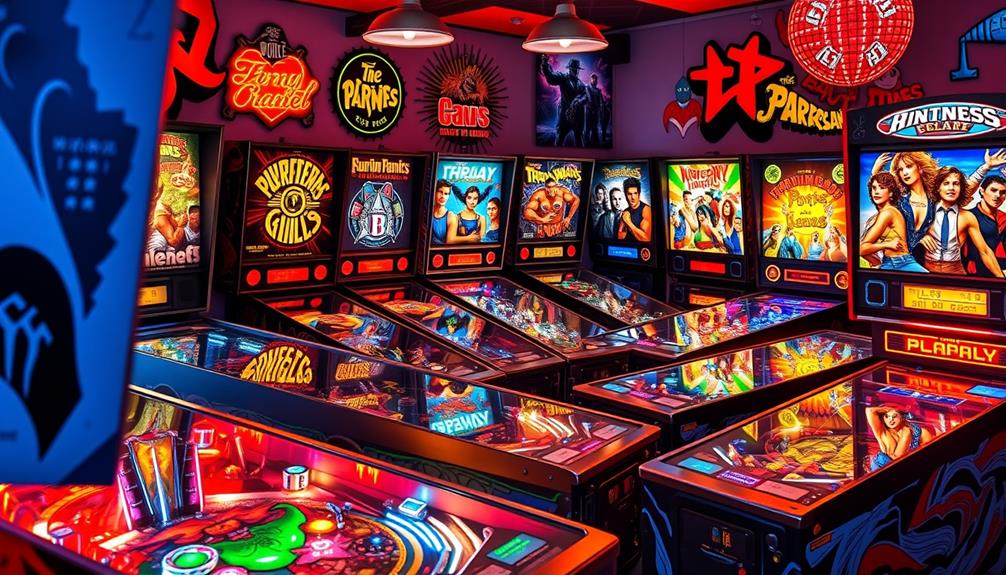
When you think about pinball machines, movie and TV themes probably come to mind first.
These designs not only capture iconic characters and scenes but also create an immersive experience that keeps you engaged.
Sports and adventure themes add another layer of excitement, appealing to fans who love the thrill of competition and exploration.
Movie and TV Themes
There's something undeniably enchanting about pinball machines that draw inspiration from beloved movies and TV shows. These machines have captured the hearts of players since the 1970s, becoming a staple in arcades. Notable titles like "The Addams Family" and "Batman 66" showcase how movie and TV themes enhance the gaming experience.
When you play a themed pinball machine, you'll notice how they integrate various elements that elevate your immersion:
- Iconic Soundtracks: The music and sound effects transport you directly into the story, making each flip more engaging.
- Stunning Artwork: The vibrant visuals reflect the essence of the source material, creating a feast for the eyes.
- Complex Gameplay: Interactive features and narrative-driven mechanics offer unique challenges that keep you coming back for more.
Machines like "Back to the Future" and "Austin Powers" exemplify the successful melding of gameplay with cinematic themes.
For collectors, these nostalgic machines are prized possessions, contributing to the thriving market for vintage pinball machines based on popular movies and TV series.
Sports and Adventure Themes
As pinball machines evolved, sports and adventure themes emerged as popular choices, enchanting players with their dynamic designs and engaging gameplay. Sports-themed machines like "A.G. Soccer-Ball" and "All Star Baseball" draw in fans by capitalizing on beloved athletic events. Meanwhile, adventure-themed titles such as "Alien" and "Adventures of Rocky and Bullwinkle" provide immersive experiences based on fascinating narratives and characters.
The surge in popularity of these themed machines during the 1970s paved the way for a boom in licensed titles from movies and TV shows. The diverse themes allow manufacturers to cater to various interests within the gaming community, making pinball more accessible and appealing.
Here's a quick overview of some popular sports and adventure-themed pinball machines:
| Theme Type | Notable Titles | Key Features |
|---|---|---|
| Sports | A.G. Soccer-Ball, All Star Baseball | Engaging gameplay, athletic events |
| Adventure | Alien, Adventures of Rocky and Bullwinkle | Narrative-driven, interactive mechanics |
| Sports | NBA Fastbreak | Multi-ball play, team competition |
| Adventure | The Lord of the Rings | Story progression, character quests |
| Sports | Play Ball! | Classic arcade feel, competitive play |
These themes continue to fascinate players, showcasing the rich variety in pinball machine designs.
Trends in Pinball Production

Since the 1930s, pinball production has undergone considerable transformations that reflect changing consumer interests and technological advancements. The number of unique pinball machine designs has reached approximately 5,000, showcasing the game's evolution over the decades.
The production peaked in the 1970s and 1980s, particularly with the rise of themed machines. Here are three key trends in pinball production:
- Themed Machines: The introduction of machines based on movies and TV shows considerably boosted popularity during the peak years.
- Declining Production: By the 2000s, fewer than 100 machines were produced annually, primarily modern DMD machines, indicating a decline in traditional production methods.
- Resurgence of Interest: Despite challenges, there's a renewed interest in classic machines, especially from the 1960s and 1970s, spurring demand for restoration.
Today, the pinball industry maintains a mixed outlook.
While traditional production faces hurdles, innovative machines incorporating advanced technology and unique gameplay experiences continue to emerge. This blend of nostalgia and modernity keeps the pinball spirit alive, ensuring its relevance in gaming culture.
The Collector's Market Dynamics
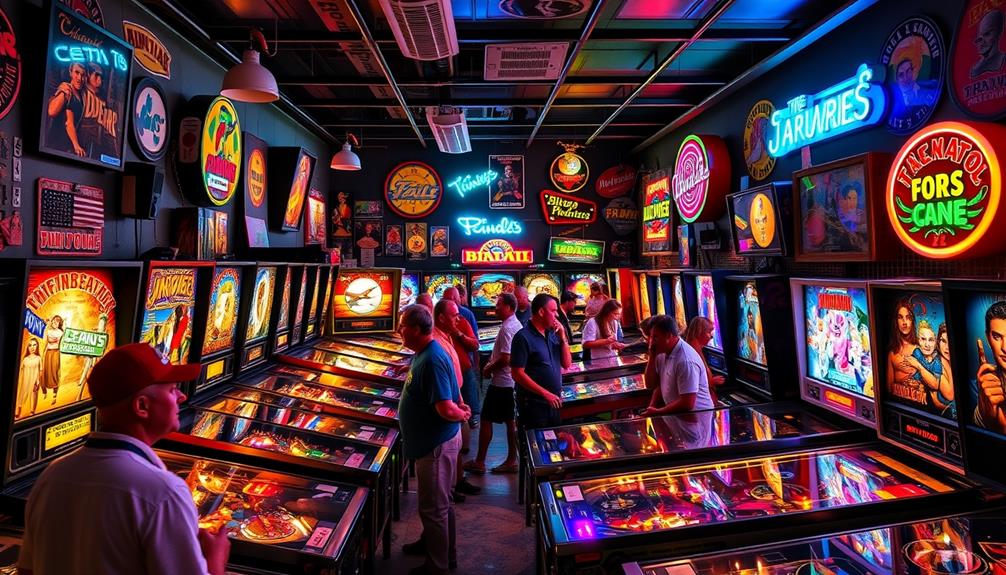
In recent years, the collector's market for pinball machines has experienced dynamic shifts, driven by a blend of nostalgia and modern interest. With over 3,000 unique models and roughly 5,000 designs recorded since 1930, collectors are drawn to vintage machines from the 1960s and 1970s, which command high prices based on rarity and condition.
You might find that used pinball machines typically range from $300 to $500, but classic models can fetch considerably more in the collector's market.
The community of collectors, estimated at 2,000 to 5,000 enthusiasts worldwide, is growing increasingly diverse, with more women joining this formerly male-centric hobby.
Digital platforms like the Internet Pinball Database (IPDB) play an essential role in this market, providing critical information about machine history, which helps you research and accurately value your collection.
As you navigate this evolving landscape, understanding these dynamics can greatly enhance your collecting experience. The interplay of nostalgia, rarity, and community engagement continues to shape the collector's market, making pinball machine collecting an exciting venture for enthusiasts like you.
Restoration and Maintenance Practices
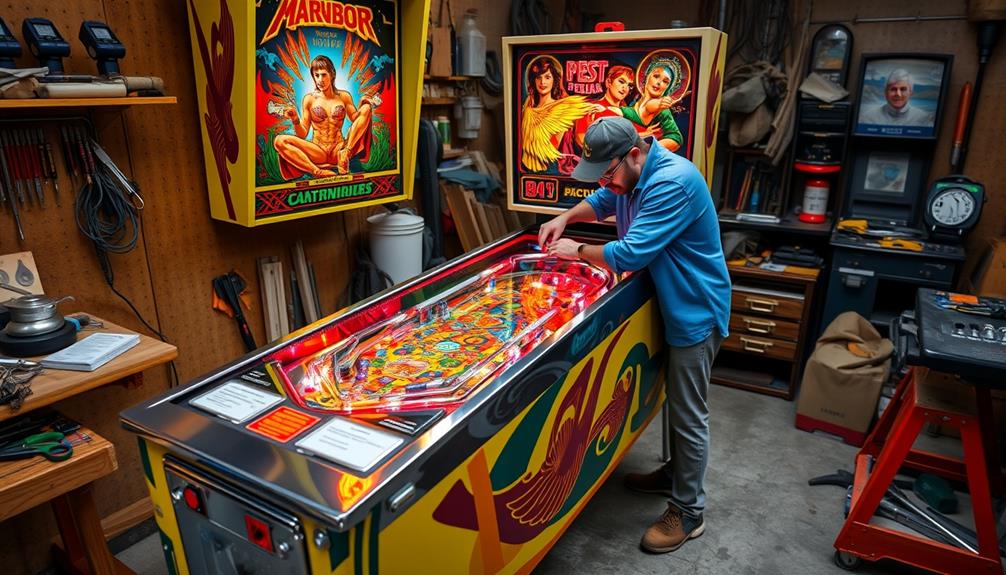
Regularly maintaining and restoring pinball machines is crucial for keeping them in top shape and preserving their value. Engaging in restoration and maintenance practices not only enhances gameplay but also guarantees that your investment remains secure.
You'll want to focus on these key practices:
- Thorough Research: Understand your machine's specifications and history. This knowledge will help you identify what needs attention during restoration.
- Self-Sufficiency: Since professional repair services can be limited, develop your skills in machine mechanics. This way, you can tackle repairs and routine maintenance confidently.
- Utilize Resources: The Pinball Resource houses over one million parts, making it a crucial resource for any enthusiast looking to keep their machines operational.
Restoring a pinball machine often requires 40 to 80 hours of labor, so be prepared for a significant commitment.
Many collectors refurbish vintage machines, with prices typically ranging from $300 to $500 based on condition. By engaging with fellow collectors, you can gain valuable insights and support throughout your restoration journey.
Community and Culture of Pinball

Embracing the vibrant community surrounding pinball can enhance your experience as a collector or enthusiast. With an estimated 2,000 to 5,000 pinball collectors worldwide, mainly men aged 25 to 55, you'll find a passionate group enthusiastic to share their love for the game.
The community often gathers in clubs, competitions, and conventions, creating lasting friendships and camaraderie over a shared passion.
Online platforms like Pinside play an essential role, offering forums where you can exchange knowledge, experiences, and insights about machines and restoration techniques.
You'll discover that community support is invaluable, especially when tackling self-sufficient repairs and restorations. Many collectors learn from one another, as professional services can be limited.
As the demand for classic and vintage pinball machines grows, so does the excitement within the community. Prices for used machines vary greatly, making it essential to connect with fellow enthusiasts to navigate the market.
Ultimately, participating in this community can deepen your appreciation for the craft of pinball, ensuring you never feel alone in your journey as a collector.
Future of Pinball Machines
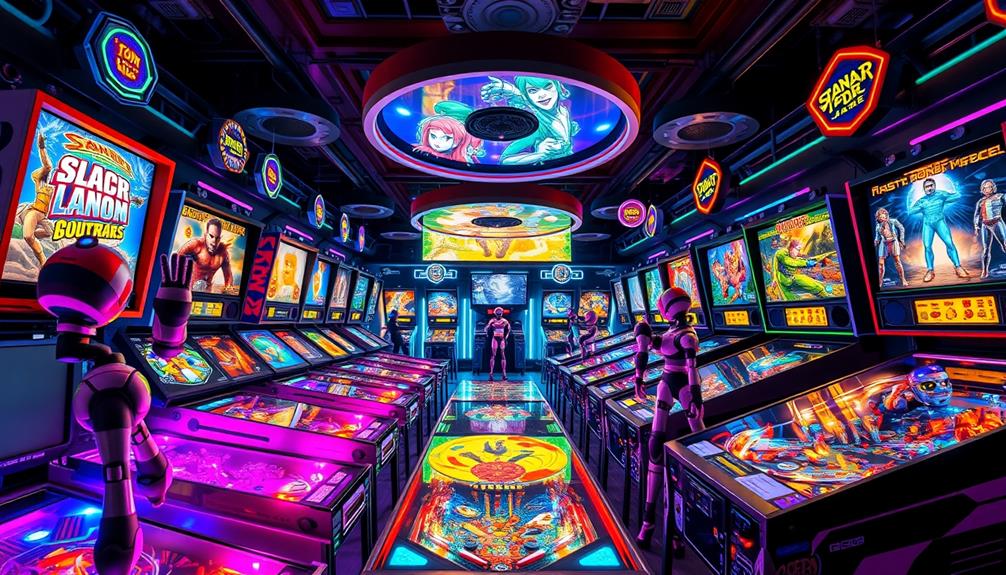
As you connect with fellow enthusiasts and learn about the rich history of pinball, it's exciting to look ahead at what the future holds for this beloved game.
The pinball industry is thriving, with manufacturers like Stern Pinball leading the way. They're producing machines that incorporate cutting-edge technology, guaranteeing the future of pinball machines remains bright.
Here are three key trends to watch:
- Innovation: Expect ongoing advancements, like color LCD screens and Wi-Fi connectivity, making gameplay more engaging and interactive.
- Collector Market: A growing interest in classic machines is creating a vibrant collector community, guaranteeing that nostalgia continues to play a significant role in the hobby.
- Community Engagement: Strong involvement in forums, leagues, and tournaments fosters a supportive environment, welcoming both newcomers and seasoned players.
As you navigate this evolving landscape, remember that the resurgence of themed and technologically advanced machines is a home run for the industry.
The potential for growth in niche markets and home collections guarantees that pinball will remain a cherished pastime for years to come.
Frequently Asked Questions
What Is the Most Famous Pinball Machine Ever?
The most famous pinball machine is "The Addams Family." Released in 1992, it captivated players with its unique features and engaging gameplay, becoming a beloved classic that still holds a special place in pinball history.
What Is the Most Sought After Pinball Machine?
The most sought-after pinball machine is "The Addams Family." With over 20,000 units produced, its unique gameplay and nostalgic appeal make it a top choice among collectors, often fetching impressive prices at auctions.
How Many Stern Pinball Machines Are There?
You'll find that Stern Pinball has produced over 100 different machine models since 1986. With titles like "The Walking Dead" and "Jurassic Park," their innovations keep players engaged and excited about pinball's future.
What Is the Most Complex Pinball Machine?
You're likely to find "The Twilight Zone" as the most complex pinball machine, with its intricate rules, multiple multiball modes, and unique gumball mechanism, demanding both strategy and skill for an engaging gameplay experience.
Conclusion
As you explore the world of pinball machines, you realize it's more than just flipping flippers—it's a vibrant tapestry of history, innovation, and community. With thousands of unique models reflecting diverse themes, each machine tells a story. Whether you're a collector or a casual player, the thrill of the game connects you to a nostalgic past, like the jingle of a quarter in a slot machine, reminding you of simpler times filled with joy and excitement.
